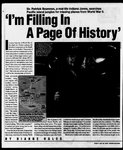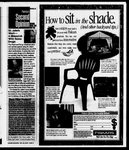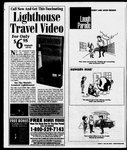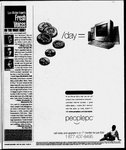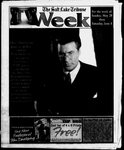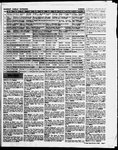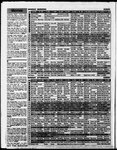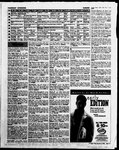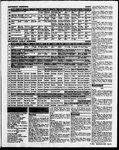| OCR Text |
The Salt Lake Tribune BUSINESS Sunday, May 28, 2000 Marketing Savvy Puts Gatorade Far Aheadof Rival Sport Drinks Now,parent company QuakerOats is declaring war on tap water THE ASSOCIATED PRESS caught on beyondits core markets CHICAGO — It crushes the competition on sidelines, finish lines and checkoutlines. Its name on thecoasts, costing Quaker$1.4 is as synonymous billion by the time it dumped it in 1997. Gatorade’s deeper roots con- with sports vinced Quaker that consumers could guzzle much more of the sports beverage. drinks as Kleenex is with tissues and Frisbee with flying discs. Long the thirst-quencher’ of choice for jocks and other heavy It was developed by University powerhouse product in supermar- of Florida researchers to help prevent dehydration. Tested on the kets and conveniencestores.It has football team starting in 1965, it sweaters, Gatorade has become a onlyone real rival. “The biggest enemy is tap water,” pronounced Robert Morrison, chief of Gatorade’s parent, Quaker Oats Co, during a recent interview. Morrison wasn’t joking. Gatorade haseffectively declared war on water. The company has rolled out more flavors, added multipacks and new bottles and employed a special sales force to expand Gatorade distribution. Coming off strong debuts for its Gatorade Frost and Fierce brands the last two summers, it also has introduced a flavored “fitness water” ¢alled Propel, a lower-calorie Gatorade spin-off. That aggressive strategy is pro- jected to help pad Gatorade’s U.S. sales by two-thirds, or $1 billion, over the next five years. The beverage already commands 82 per- centof the U.S. sports drink marKet and had 1999 worldwidesales of $1.83 billion. Quaker’s stated goal: Make Gatorade available everywhere that there is water. “When we're done, tap water MBAIs Suffering Under New Economy @ Continued from E-1 A scientist pours Gatorade into vessels that will be used to study how people rehydrate whenthey drink Gatorade. will be relegated to showers and washing dishes,” Susan Welling- ton, president of Quaker’s U.S. beverage division, boasted playfully to a group of New York analysts recently. It may be quietly moving in on Coke and Pepsi, too. Having conquered the sports drink arena, Ga- torade has eased into the mainstream beverage market. “It’s disguised as a sports beverage, so as not to anger Coke,” says analyst Nomi Ghez of Goldman, Sachs & Co. “But in reality it’s a major entry in the general beverage industry. You see kids walking around drinking Gatorade — they’re not sweating.” Quaker’s big push into Gatorade, now its No. 1 product with more than 40 percent of company wascredited with helping to give the Gators a reputation as the “second-half team”for outplaying their opponents in thefinal half. Stokely-Van Camp bought the rights and Gatorade soon went near-nationwide. But when Quaker acquired it in 1983, there were still only two flavors and modestsales of $97 million. Howit became a dominant consumer brand is described by experts as nothing less than a marketing coup. Early on, Quaker took steps to enhance Gatorade’s reputation as certifiably good for performance, founding the Gatorade Sports Science Institute. By the early 90s,it locked in most major professional sports leagues to long-term Gatorade contracts, providing immeasurablevisibility. Michael Jordan was signed toa 10-year promotional deal in 1992, giving Gatorade priceless Photos by Ted S. Warren/The Associated Press Above,triathlete Michael Scott rides a stationary bike at the Gatorade Sports Science Institute in Barrington,Ill., while scientist Craig Horswill keeps an eye on his progress. Horswill leads a research team that studies Gatorade by monitoring howtest subjects absorb the drink during exercise and rehydration. 5” exposure. Budding superstars — The primetargets are closer to including soccer player Mia Hamm, quarterback Peyton Manning and NBA star Vince Carter — are. currently providing newer marketing clout. And more than a dozen flavors have been added. _ “It's become a mainstream, New Economyproduct,” says ana- lyst John McMillin of Prudential Securities. “They’ve succeeded in expanding beyondthe male athlete stereotype to reach less serious athletes, females, kids as young as Despite marketing costs, sales and profits keep surging. Profits topped $250 million last year, Ga- ‘home. Morrisontapshisforefinger on a pie chart showing Gatorade with only7 percentof what he says torade’s fastest-growing year ever is a $10 billion U.S.“active thirst” with a 12 percent rise‘in U.S.sales. PowerAde, made by Coca-Cola, and PepsiCo’s AllSport are dwarfs by comparison. The global frontier remains largely unconquered for Gatorade, although it is sold in 47 countries. Disappointing results in Europe, outside Italy, have slowed its advance. market — beverages consumed by people when they are hot and sweaty. The biggest share, 35 percent, is held by tap water. “This is the big opportunity,” he says, pointing to the largeslice. “We're not against water — it just has its place,” he deadpans. “It's good for irrigation and sales, might surprise some whore- memberits disastrous acquisition of Snapple. That drink never Conversely, society benefits if busifhess graduatesare equipped to deal with warp-speed change. That means new approaches, _ newclasses and new people. Florida International University’s (FIU) College of Business Administration, for instance, recently hired Kuldeep Kumar, a na- tive of India who had been an e-education consultant in Europe. ,threat, are on top of it or feel insulated. : “A Stanford MBArepresents a unique educational experience swith substantial lifetime value,” » said Robert Joss, dean of the busi“fess school. “Wharton is bustling with activity from early in the morning until late at night,” said dean Patrick Harker. “Learning is happeningin the hallways, at the pub, etc.” “We're notinsulated from risk,” said Clark, the Harvard dean who was Christensen’s thesis adviser and is intimate with the theory of disruptive technology. “We're not sittingstill.” He said Harvard has been providing research since the 1920s, publishes the Harvard Business Review with 230,000 paid subscribers,sells 6.5 million case studies a year and replenishes 7,500 active cases by writing 600 to 700 new ones a year. That stream of cutting-edge thought will prevent any erosion » in Harvard'sinfluence,Clarksaid. The apparentstrategy is to sup- ply that expertise, to become the “Intel Inside,” of corporate training, Christensensaid, referring to the successful company that makes the chips of computing equipmient. “Butthe business modelis very, very different,” Christensen warns. Harvard's cases are “often quite difficult for other instructors to use.” Top schools say research will be their salvation and predict the less prestigious MBA programs that only teach are in danger of going His challenge is formalizing and implementing the school’s ecommerceinstruction. The school has named its effort Crossroads: An e-Business Initiative. The goal is to “try to infuse the electronic commerce component in each area,” Kumarsaid. “Even the leading schools haven’t done much yet, and that’s where I see our competitive advantage occurring.” But technology, he added,isn’t just changing how managers analyze numbers. It’s transforming the corporationitself. In the not-so-distant past, the predominant modelwasbased ona theory called vertical integration. It meant large firms controlled virtually every part of their operations, from marketing. manufacturing to Today, smaller companies, and global partnering with outside firms, is more the norm — made possible by computer links and real-time communication around the world. Courses on how to deal with these changes are sprouting up. “With technology changing, businesses have found new waysof doing business,” Kumar said. “Models we developed overthe last 50 to 60 years are relevant, but not to the extent”they once were. “The insides of companies have changed.” Students who can command technology and business skills seem to bring a premium on the market. Carolina Rodriguez, an FIU business graduate, is an example. Her command of Microsoft Excel helped her in an internship at Burdines. “T loved it,” she said. “We were analyzing operations, keeping merchandise moving.” Now sheis going there permanently as an assistant buyer, which is somewhat surprising since her field of concentration * was human resources. “Manystudents don't go into what they study,” she says. And the reality is, in a world of School of Business of Nova Southrapid change,all jobs are going to eastern University in Fort Lauderchange a lot anyway. dale has 530 students enrolled in an But that means a formal busi! 18month eMBA ness education is more valuable, Eventually, every business reaches the point ‘Hype about the New Economy where it’s impossible to go on without an aside, the U.S. economy is robust because ally. Someone you can turn to for personal attention, honest communication, and the journey takes you and your business. We're ge Tlelig)as with you 110%. To learn more, drop by a First Security branch, call our Small Business SolutionLine at 1-800-574-6696 (option #2), or visit our website at business specialists at First Security, We'll wwefirstsecuritybank.com, First Security help you get there—no matter where the Bank Member FDIC. |













































































































































































